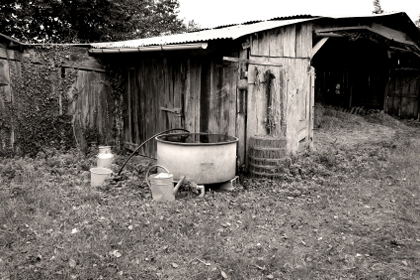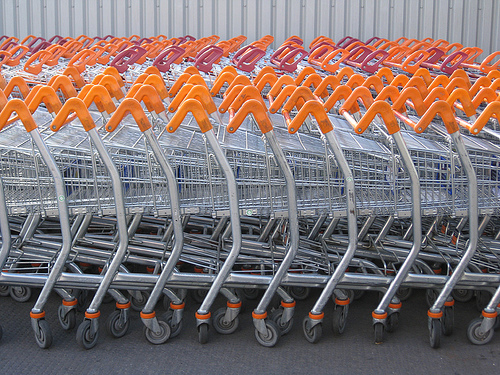Archive for the ‘Frugal Living’ Category
Fabulous Fungi

Here’s a riddle for you: What flourishes without light, doesn’t use flowers or seeds to grow and is so diverse it can even be grown in your hall closet?
Its mushrooms of course!
Mushrooms are unique because they are not plants at all – they are fungi. They reproduce with spores not seeds and they don’t contain any chlorophyll or go through photosynthesis like regular plants. That’s why they can grow in cool, damp, dark places instead of warm, sunny ones.
The nutrients mushrooms need to grow come from a growing medium called substrate—usually a rotting log or a “brick” of straw, rice bran or sawdust in bags. A mushroom is really the fruit of the fungus; the actual “plant” if you will, is a network of root-like threads, called the mycelium. Mushrooms reach harvestable size in several weeks and can be picked for about 15 weeks.
To begin growing your own, first decide what type of mushroom you’d like to grow, as each variety likes a certain type of growing medium. It may be a good idea to start with an easy growing variety that can be found in a kit, like the shiitake or oyster, for first-timers. Kits will come complete with the right kind of substrate for the mushroom variety, mushroom spores and growing instructions.
If you decide to grow mushrooms without the aid of a kit you’ll need to do a bit more research. First, find the right kind of growing medium for the variety you want to grow-each mushroom variety has its own preferred growing conditions. While most favor logs, straw or sawdust, some will grow on used coffee grounds and even on corncobs. The medium will then need to be sterilized with heat, tightly compacted in a bag or on a tray and then inoculated with the spawn. A word of caution here: resist the temptation to use free spawn from wild mushrooms; purchase good healthy spawn from a reliable supplier.
Be sure to check out the growing habits of the variety you decide to grow so you know how and where to place your growing container. Some mushrooms grow vertically, as they would on a rotting log, and hanging them would be an ideal solution. Others grow horizontally in little clusters as they would on the floor of a dark, clammy forest. These can be grown in a tray placed in a dark closet.
Once your mini mushroom farm is set up all you have to do is water it, set it in a dark place and keep an eye on the conditions. In about a week you’ll see the beginnings of tiny little mushrooms. Depending on the variety you should have “ready to harvest” mushrooms in another 4 to 8 weeks.
How simple is that?
Before you know it you’ll have your very own ethereal fairy-garden of perky little mushrooms.
To learn more about growing mushrooms, check out www.fungi.com and www.gmushrooms.com. The Mushroom Company at www.mushroomcompany.com is a commercial grower site, but has lots of useful information.
To read more about growing mushrooms, check out “Growing Gourmet & Medicinal Mushrooms”, by Paul Stamets.
If growing mushrooms isn’t your thing, you can still enjoy them with these simple recipes. Read the rest of the story »
A Life Lived in Grace

This beginning of a New Year is like a bend in a winding mountain road. It fades in my rearview as we move farther and farther from its starting point. I’ve been reflecting lately on all that can be accomplished on a small suburban homestead such as ours and feeling rather – well – contented and secure.
On just a third of an acre we are able to raise lambs and chickens to put meat in our freezer and eggs for breakfast and baking. An extra lamb we butchered is being parceled out to friends and neighbors who don’t want a whole or half lamb. And, at $9 to $15 per pound for organic lamb, I think this may turn out to be a very good thing.
The broilers we raised from day old chicks were butchered last week. Our original plan was to butcher before Christmas, but the bad weather and family obligations forced us to push back a few weeks. With the extra time on feed most of the birds were in the 7 to 8 pound range, with a few pushing over 9 pounds. At those weights the birds are too big for a family of two, so most were cut in half and a few quartered, giving us enough chicken for about 30 weeks, assuming we eat chicken once a week. Not bad, folks! Not bad at all!
The hens are laying 5 to 7 eggs a day now, not quite at full stride yet, but, that’s 3-1/2 dozen a week, enough to keep us in omelets with a few dozen left over to sell to cover feed costs.
Our berries and fruit trees are coming into their own and give us plenty of fresh seasonal fruit for eating and a little extra for freezing or canning or cooking; the garden gives us plenty of greens and root vegetables; tomatoes and cucumbers; squash and pumpkins, even with the occasional crop failure.
Thanks to some great sales in November and December our pantry is brimming with staple goods. And, the added savings from coupons meant most were “free” or nearly “free”. It’s so nice to be able to just walk over, open a cupboard and pull out what you need for an evening meal. No treks to the store after dark. No drives during inclement weather.
We picked up another load of firewood from the grandparents’ place, our second of the winter. With the colder temperatures we are burning more wood than in years past and it’s a blessing to have such a ready source. Loading split wood on a cool afternoon makes for a robust workout. I love it.
I think these reflections were brought on by a morning news story on the inflationary period coming our way. Read the rest of the story »
Honey Bee Crisis = Food Crisis

Over the last three years more than one in three honey bee colonies has died nationwide, posing a serious risk to our natural food supply. One cause for the losses is a phenomenon called Colony Collapse Disorder, or “CCD.” When a hive experiences CCD, honey bees mysteriously abandon their hive and die. Researchers don’t know exactly what causes CCD, but believe some contributing factors may be viruses, mites, chemical exposure and poor nutrition.
Why is this a crisis? Because, honey bees are responsible for pollinating one-third of our country’s natural foods. Think about it…one out of every three bites of food an average American eats has been pollinated by a honey bee. These industrious workers are responsible for pollinating more than 100 different varieties of fruits, vegetables, nuts and seeds, and they provide 80 percent of the country’s pollination services. The honey bee is responsible for $15 billion in U.S. agricultural crops each year because they fly up to 15 miles per hour and visit about 50 to 100 flowers on each pollination trip. It takes 2 million flower visits, covering 55,000 miles to make one pound of honey. When a honey bee returns to the hive after finding a good pollen source, it gives out samples of the flower’s nectar to its hive mates and performs a dance that details the distance, direction, quality and quantity of the food supply. The richer the food source, the longer and more vigorous the dance.
What can homesteaders do to preserve the hum of honey bees and thereby help sustain their own gardens and production? Plant a seed! It’s that simple. Read the rest of the story »
Rainwater Collection

Our rainy season started the week before Christmas. Local weather reports predicted 7 days of rain, with 5 to 10 inches; an unusual storm system for our area. But, rather than lament the wet conditions and slippery roads homesteaders should rejoice in the ability to collect “free” water that can be used in the garden during times of limited rainfall. The collecting of rainwater is as old as time itself. Many ancient cultures collected and stored rainwater for use during drier months of the year.
Did you know a single 20′ X 30′ roof can yield over 13,000 gallons of rainwater from one 10-inch rainstorm? If homeowners capture only a fraction of that, it’ll go a long way toward preserving a rapidly diminishing fresh water supply. This has been particularly important to me because our municipal water rates have gone up another 10%, making this increase the fourth this year. A local paper reported that our town’s water rates have increased 67% in the last 5 years and over 109% in the past ten years. Forget gold, folks – water will soon be the bankable commodity everyone is clamoring for.
Several years ago I got serious about collecting rainwater. My system is simple yet very effective. A series of connected barrels line the north side of my house. A downspout is attached to the first barrel, which feeds all the others when it is full. When all barrels are full the downspout is moved, diverting the runoff away from the full barrels. I use recycled 55-gallon barrels that once held juice concentrate, which means they are food grade with no chance of having been exposed to chemicals or other harmful liquids. And, for the reasonable price of $35 each I can buy several for the same price as one expensive commercially sold system.
To set up your own rainwater collection system check out this helpful link www.wikihow.com
With the step-by-step instructions and great photos, you’ll be collecting rainwater (and saving money) in no time.
Now that’s what I call pennies from heaven.
Seasonal Sales Calendar

With the year coming to a close it’s a great time to lay the groundwork for stocking your pantry and home with needed items. An effective way to shop for food storage and other household items is to know when they typically go on sale.
Some of this is common sense. Seasonal items like winter coats generally go on sale by the end of December while gardening supplies can be purchased for less in the fall. But, some great information can be found on the Consumer Reports website, websites on stocking up and store ads. The Calendar below is just a sample of the items you can stock up throughout the year, helping to build a well supplied pantry and save money on other purchases. Be patient. Watch store ads for items that are 50% off or more. Shop when items are on sale. As time goes by and your pantry grows you’ll be spending less time in the market and more time shopping from your own pantry!
(Keep in mind that this is just a generalized list. Every part of the country is different and sale times and items may vary) Read the rest of the story »
Sneaky Stores – Savvy Shopper

Department stores may have dozens of ways to trick shoppers into spending more than they normally would, as described in this Daily Finance article , but they haven’t fooled this savvy shopper. Traveling down my path to a more frugal lifestyle full of experiences rather than stuff I have learned to spot these tricks and have a few of my own up my sleeve as well.
I rarely shop major malls any more. I usually buy only what I need rather than trendy “want” items. And, when I do purchase items I favor second-hand or thrift stores over department or specialty stores. I’ve recently discovered the last Friday of the month sales at the Salvation Army in my sisters town. Each time I’ve been I’ve found wonderful quality clothing, house wares and furniture.
I’m not much of a designer brand person. I would never pay those outrageous prices for a pair of jeans. But, if I can find good quality garments for a few dollars who cares whose name is on the tag. The greater point is to find items that will last for several seasons or several years. And that’s what I’ve done. On my last trip I found 3 pairs of Coldwater Creek jeans, in excellent condition, for $3 each; Land’s End long-sleeved t-shirts, great for wearing under my wool sweaters, for $1.50, a large ceramic mixing bowl for $2, 30-feet of garden fencing that will be perfect around new transplants or emerging seeds for $4, and an emersion blender, ideal for making pureed soups, fruit butters and of course smoothies, for $3.
But, my savvy shopping doesn’t stop there.
Ever get those $10 off cards or coupons in the mail or stuck to the Sunday paper? Well – if you’re a savvy shopper you can use them to your advantage, get what you need and not pay much (or anything) at all. I get them all the time and now have a few family members and friends that save them for me as well. I always carry a list of small items I need for the house.
The trick is to have a list of items that are priced at $10 or just over. Wait for the coupons to come out and then buy only one of those items with each coupon. If they don’t have the item you’re looking for – walk out of the store. Don’t wander around trying to find a replacement. Retailers know the longer a consumer is in the store the more likely they are to make a purchase. In the last month or so I’ve been able to buy four seasonal pillar candles ($.84); two short-sleeved t-shirts ($1.30); a package of sport socks (free); a scarf (free) and leather gloves for my thrift store raincoat ($4), and a frame for my daughters county fair picture ($1.69). Not bad. Not bad at all.
It’s a game and I’m playing it the best I can. Why spend good money on things that don’t matter? Why should I care what brand of jeans I wear while cleaning the garden or working the sheep. The truth is I don’t; don’t care to spend money on those things when it could go towards new livestock, our spring seed order or new equipment.
So, come on, folks. Play the game with me. See how much you can save. See how frugal you can become.
![]() photo credit: chocolategirl64
photo credit: chocolategirl64
The Penny-Pincher’s Guide to Car Maintenance
Save money without compromising your safety or your car’s well-being
Food on the table or new tires for the family jalopy? An easy answer for most people. But driving on worn tires poses a safety risk. So, too, can a mechanical breakdown that leaves a car and its passengers stranded on the freeway.
Tough times can mean tough choices for folks struggling to make ends meet. Auto Club data suggest that drivers are skimping on car maintenance, leading to a variety of mechanical failures and breakdowns. During the first half of this year, roadside assistance calls increased by 7%, an unusually high number.
Moreover, drivers are keeping their cars longer. In just one year, the average age of the nation’s cars has risen from 10 years to 11 years, an extraordinary increase, says John Nielsen, AAA national director of auto repair.
Unfortunately, older cars require a higher level of maintenance to keep them running. The upshot? More motorists are experiencing firsthand the finite life of automotive parts.
Now or Later
Skimping on basic maintenance is false economizing, because if you keep up with low-cost minor adjustments to your car, you likely won’t have to pay for high-cost major repairs later. Or, as the mechanic in an old TV commercial for oil filters said, “You can pay me now, or pay me later.” For instance, if you replace a car’s dirty fuel filter for $50, you could avoid the $500 bill you’d have to pay for replacing a ruined fuel pump. Spending several hundred dollars to change an engine’s timing belt is far less costly than spending thousands for an engine rebuild. And the list goes on.
If you find penny-pinching to be a necessity these days, be assured there are ways to pinch those pennies while still being car smart. Based on feedback from the Auto Club’s Roadside Assistance and Approved Auto Repair programs, as well as test data from the Auto Club’s Automotive Research Center, here are 12 suggestions that can save you money by helping to prevent common breakdowns. Read the rest of the story »
Frugal Housekeeping Tips

Are you beginning to notice how so much of what we use to run our homes is inter-connected? The way in which we wash dishes affects our water and heating; electrical or gas usage. And, windows, doors, and insulation have a direct connection to the cost of heating and cooling our homes. But, what about keeping your home clean? What tricks and tips can you use to lower the cost of keeping your home squeaky clean?
It’s simple. Take a clue from the women of old and use natural, basic and inexpensive supplies for keeping your home clean and fresh. Newspapers or cotton t-shirts, cut to size, make great towels for washing windows. T-shirts, old cotton socks or cotton diapers can be used as dusting cloths, while threadbare towels make good cleaning rags. Keep a box close by to collect and store these items as they come available.
To get started gather up a few ½-gallon or gallon jugs, spray bottles, cheese grater, measuring cups, bowls and spoons for mixing, and labels. You’ll want to keep these items separate from other kitchen utensils so try to find a nice box or bin to store them in. Thrift stores are a great place to find these items inexpensively.
Many of the ingredients needed may already be in your home, like baking soda, distilled water, white or cider vinegar, salt, lemon juice, olive oil and essential oils, but if they are not, they can be purchased at most stores. You’ll also want to add Borax laundry booster, washing soda, Castile soap (liquid and bar), ammonia and these essential oils; lavender for repelling insects, tea tree for an antibacterial and fungicide; and lemon, orange or tangerine for grease cutters.
Laundry detergents are probably one of the most expensive items we buy for cleaning. But, did you know that in powder form almost 75% of the detergents contents is chalk? And more than half of the liquid brands are water. In fact, most cleaning supplies are mostly additives to fill the packaging. But, with just a few ingredients and a few minutes of your time you could be making your own supplies and saving bundles. Here are a few recipes to get you started. Read the rest of the story »
Frugal Living – Saving On Electricity
Electrifying Ideas to Control Your Use of Electricity

To save on electricity, pay close attention to the biggest users. You’ll save more electricity (and money) by dealing with the biggest electricity-guzzlers first rather than worrying about whether it’s better to boil a cup of water on an electric burner or in a microwave. With that in mind, concentrate on your BIG energy users, which are:
Heating, Air Conditioning, Lighting, Washers, Dryers, Refrigerator, Water Heater
As we mentioned earlier, raising or lowering the thermostat will go a long way to reducing your electric bill. So, let’s look at the rest of the list.
Lighting: For appliances or electronics that are close together, plug them into a power strip. That way you can turn them all off at once when not in use.
For areas, like stairways or dark hallways, where you want a light on all the time use lower wattage bulbs. A 15-watt bulb can reduce electricity by 80% over a 75-watt bulb.
Place lamps in corners where their light can bounce off the walls and be more effective.
And, of course, use energy-efficient compact fluorescent light (CFL) bulbs when ever possible.
Washers: To save on water and electricity run only full loads of dishes and let them air dry. The same holds true for laundry. Wash only full loads and dry using a clothesline.
Washing in cold water and using a cold water detergent will also save on the cost of heating water.
Clothes Dryer: If clotheslines are not your thing or if they are not allowed in your area use the moisture sensor option so the dryer turns off automatically when clothes are dry.
Make sure that dryer loads are not too small or too big for the dryer capacity. And, remember to empty the lint trap after each load. This will help the dryer to work more efficiently.
Refrigerator/Freezer: Routinely vacuum condenser coils. Dirty coils affect the efficiency of the compressor which translates to increased electric cost.
Do not place uncovered liquids in refrigerators. Not only do they absorb undesirable flavors, liquids give off vapors that add to the compressors workload.
Additional freezers or refrigerators should be kept in the house or basement when ever possible, not the garage. The fluctuations in winter and summer temperatures make these appliances work harder which in turn uses more energy.
Water Heater: You can reduce your water heating bill by 10% by lowering the water heater temperature from 140°F to 120F°. (Keep the temperature at 140°F if you use an older dishwasher though. This helps sanitize the dishes)
Once a year, drain a bucket of water from the bottom of the water heater tank. This gets rid of sediment, which can waste energy by “blocking” the water in the tank from the heating element.
Insulating your hot water supply pipes will reduce heat loss. (Hardware stores sell pipe insulation kits.)
For older water heaters, consider buying a water heater insulation kit, which reduces the amount of heat lost through the walls of the tank.
Click here for more energy savings tips.
![]() photo credit: bigandyherd
photo credit: bigandyherd


Recent comments
Aenean nonummy hendrerit mauris. Phasellus porta.